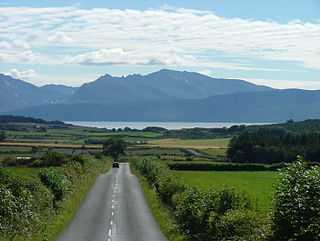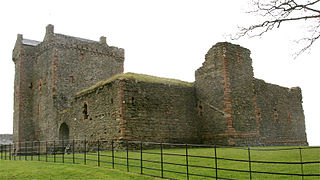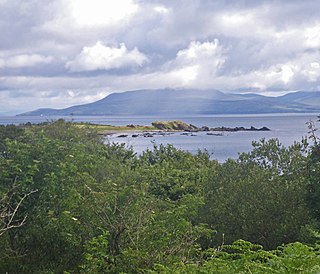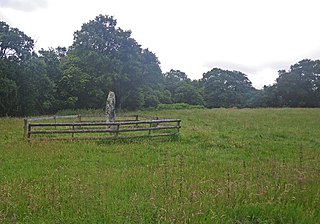
Carradale is a village on the east side of the Kintyre Peninsula, overlooking the Kilbrannan Sound and the west coast of the Isle of Arran in the Firth of Clyde, approximately 16 miles from Campbeltown. To the north of Carradale is the coastal peak known as Torr Mor; nearby are the hamlet of Dippen and Dippen Bay. Population: 577 ~ 2024

Saddell is a small Scottish village situated on the east side of the Kintyre Peninsula of Argyll and Bute, overlooking the Kilbrannan Sound and the Isle of Arran, 8 miles (13 km) from Campbeltown on the B842 road to Carradale. The name Saddell is derived from the Norse for sandy dale.

The Sound of Bute is a broad sound, separating the islands of Arran and Bute, on the west coast of Scotland. The sound leads up from the lower Firth of Clyde and passes the island of Inchmarnock. Then splits into the Kyles of Bute, Loch Fyne and round the north end of island of Arran into the Kilbrannan Sound.

Skipness is a village and Quoad sacra parish on the east coast of Kintyre in Scotland, located just over 7 miles (11 km) south of Tarbert and facing the Isle of Arran.

Skipness Castle stands on the east side of the Kintyre peninsula in Scotland, near the village of Skipness. Together with the nearby Kilbrannan Chapel it is a scheduled ancient monument.
Torrisdale is a small village on the eastern coast of the Kintyre Peninsula of Scotland. The village is along Torrisdale Bay, an inlet of the Kilbrannan Sound. It is the location of Torrisdale Castle, a 19th-century castle that is now a tourist destination.

Sliddery is a tiny hamlet located on the Southwest coast of the Isle of Arran in Scotland. The village is situated near the Ross road between Lagg and Blackwaterfoot.

Airds Castle is a ruined medieval castle near Carradale, Kintyre, Argyll and Bute, Scotland. The castle held a position on the summit of a rocky headland between Carradale harbour and the bay of Port Righ, looking across Kilbrannan Sound to the Isle of Arran.

Kildonald Bay is a bay on the eastern side of the Kintyre Peninsula of Scotland. Kildonald Bay is an element of Kilbrannan Sound that separates the Kintyre Peninsula from the Isle of Arran. Other bays along the east side of the Kintyre Peninsula include Dippen Bay.

Torr Mor is a hill peak landform on the coastal east side of the Kintyre Peninsula in Scotland. The peak offers views over the Kilbrannan Sound. The Forestry Commission maintain a footpath over the hill.

Dippen Bay is an embayment along Kilbrannan Sound on the east coast of the Kintyre Peninsula in Scotland. Coastal erosion has been documented at Dippen Bay as well as nearby Torrisdale Bay. The bay is located along the coast near the hamlet of Dippen.

Torrisdale Bay is a coastal embayment along the east side of the Kintyre Peninsula within Kilbrannan Sound in Scotland. The shoreline of the bay consists partially of a shingle beach. Nearby is located Torrisdale Castle. The villages of Torrisdale and Bridgend lie along Torrisdale Bay with Carradale directly to the north. Bottlenose dolphins and harbor porpoises are often sighted.

The Avinagillan standing stone is a prehistoric menhir on the Kintyre Peninsula of Scotland. The stone is near the hamlet of Avinagillan.

Saddell Castle is a historic 16th-century castle on the shore of the Kilbrannan Sound near Saddell, Kintyre, Argyll and Bute, Scotland of significant importance. The original castle existed in Somerled's time in the 12th century. The castle served as a bastion of the MacDonald family for several centuries and continues to be visited by MacDonald diaspora from around the world who return to Western Scotland and the Isles. Several MacDonald Lords have resided at Saddell over the centuries, including Alasdair Mor MacDonald, younger brother of Angus Mor MacDonald, Lord of the Isles in the 13th century. Angus Og MacDonald once provided refuge to Robert the Bruce during the First War of Scottish Independence in the early 14th century before taking him on to Dunaverty Castle on the Mull of Kintyre.
Saddell Bay is an embayment along the eastern side of the Kintyre Peninsula of Scotland. Saddell Bay is an element of Kilbrannan Sound that separates the Kintyre Peninsula from the Isle of Arran. Other bays along the east side of the Kintyre Peninsula include Kildonald Bay and Dippen Bay.

Richard Holyoke was a seagoing steam tug boat built in 1877 in Seattle, Washington and which was in service on Puget Sound and other areas of the northwest Pacific coast until 1935. The vessel was considered to be one of the most powerful tugs of its time.

St Brendan's Chapel, also known as Kilbrannan Chapel, and Skipness Chapel, is a medieval chapel near Skipness, Argyll and Bute, Scotland. The chapel appears to have been built in the late 13th or early 14th century and was dedicated to St. Brendan. The chapel replaced an earlier chapel dedicated to St. Columba at nearby Skipness Castle. There is reason to suspect that the introduction of St Brendan's cult at Skipness was carried out by the Stewarts, after their acquisition of the Clann Suibhne lordship in the mid thirteenth century. By the fourteenth century, St Brendan was closely associated with the Stewarts and their island of Bute.

MV Clew Bay Queen is a car ferry at Clare Island. Built in 1972 as MV Kilbrannan for Caledonian MacBrayne, she operated mainly at Scalpay, Outer Hebrides until 1992. As Arainn Mhor, she then operated the Arranmore ferry in County Donegal.

Catacol Bay is a small shallow-curved tidal, 310° facing, rocky coastal embayment located on the northwest tip of the Isle of Arran in the Firth of Clyde, within the council area of North Ayrshire in Scotland.






















